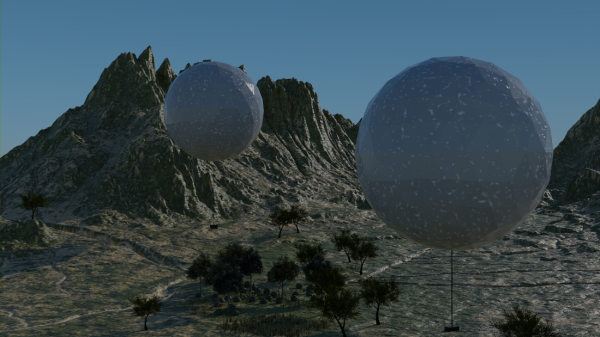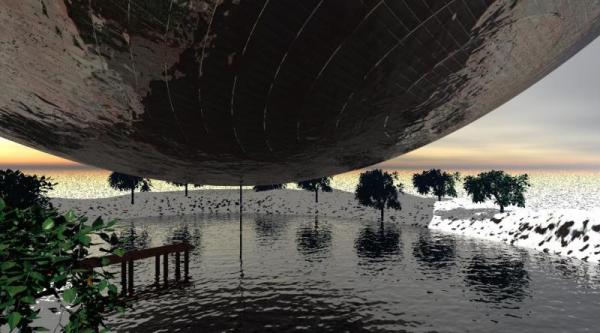BY LETTER
Fullairs
History > 0030 to 0900 AT: Solsys Era > 400 to 530 AT: The Solsys Golden Age
Technology > Technology Type or Material > Drytech/Hylotech
Technology > Application > Infrastructure
Technology > Technology Levels > Middle Tech / Midtech
Technology > Technology Type or Material > Nanotech
Technology > Technology Type or Material > Drytech/Hylotech
Technology > Application > Infrastructure
Technology > Technology Levels > Middle Tech / Midtech
Technology > Technology Type or Material > Nanotech
Airborne arcologies supported by warm air | |
 Image from Copyright Lilly Harper | |
| A typical fullair is a very large hot air balloon heated entirely by solar power, and supporting habitable infrastructure | |
Neil Bedford's airborne arcology
The first fullair, and its autofab template, was produced on Earth in 431 AT by a backyarder located somewhere in the Cascadian State of Alaska. It Is believed it was originally created to serve as a high altitude launch platform in a bid to leave the Earth. Apparently several of these spheres were to be lined up with payloads being accelerated by a mass driver hung below them but for some reason this plan never got that far and only one fullair was built by him. It was only later that it was converted into an arcology. Although the original template in now obsolete it is worth describing in some detail as its basic principles are still in use.Neil Bedford's design was based the earlier work of Buckminster Fuller and his followers. Fuller had calculated that a geodesic tensegrity dome about 1/2 mile in diameter would actually float off its foundations because at such a size the air trapped underneath the dome weighed 1,000 times that of the dome's structure itself. As such even a slight heating of this air would cause enough of it to displace that the whole thing would be lighter than the air outside. Fuller further calculated that a larger one mile diameter sphere could hold a town of several thousand people airborne on little more than the waste heat of their activities. Bedford's fullair was actually only 800 metres across but was built using lighter nanotech materials that were unknown to Fuller and it gained lift from the higher temperatures of solar heating. (Neil Bedford was an avid solar balloonist and once held the North American distance record.)
 Image from Loopquanta | |
| Neil Bedford's first Fullair is assembled above the lake on his land in Alaska | |
The sphere grew from the top down and as it grew it was clothed in a double skin; a thin, transparent outer sheet allowed light in to reach the second dark skin of paneling on the opposite side of the truss work that acted as a solar collector. As the sections were put together at first a dome was formed under the water and air was pumped in to raise it above the lake's surface so that more sections could be moved into place. When it was finished vents in the top of the outer skin were closed to prevent the circulation of cooling air through the shell and allow the inner panels to heat the air behind them, and the sphere climbed into the sky. As a buoyant structure the fullair operates as a hybrid. During the day, when it receives solar heating, it is a low density, high-pressure balloon but during the night, when the air inside cools and contracts, it becomes a low-pressure balloon with the shell under compression - it became a partial vacuum dirigible.
When Bedford decided to move his family into the fullair he replaced many of the inner panels with nanoflex. Nanoflex was the newest thing at the time but had already proven itself very versatile; not only was it useful as an omni-flexible effector with its own computing network and energy storage system but its programmable matter outer surfaces could collect (or reflect) light as needed and convert it to electricity while its inner surfaces provide lighting. The nanoflex's programmable matter could act as a crude Optical Phased Array and could have been used for many effects had Neil Bedford's programming skills (and the computing resources of the fullair) been up to challenge. However he was able to use the external imaging capabilities of the nanoflex to sell ad space and could just as easily use it to minimize the fullair's visual impact at other times, he also had some success in displaying sky images and other scenes inside to it's residents. Photonics were not his strong suit and he found it easier to sculpt the physical structure of the nanoflex itself. Among the many uses Mr. Bedford put the effector system to were; housing, vents, airlocks, planters for landscaping, air and water pumps and a maintenance system.
Because of its smaller size Bedford used his fullair more as a family estate than as a arcology city and the inside bottom half was landscaped accordingly. Near the sphere's equator the nanoflex formed a ring of private homes and greenhouses. Below this it formed crannies where mountain wildflowers could find purchase and, as the slope lessened, alpine grass could grow. Near the bottom of the bowl soil could collect in greater depth and northern trees were planted around artificial boulders (here again the nanoflex was put to use) and a large pond. Pumps in the pond circulated the water out to springs in the slopes so small streams and waterfalls could return it. The landscaping was meant to be familiar to Bedford and the plants and wildlife were all native of his family home in Alaska. The Bedford clan could now travel the world while never leaving home but they soon found the internal air temperatures needed to keep this fullair aloft in most parts of the world proved to be above the temperature range these life-forms find comfortable and Bedford was forced to make additional alterations to the design a few years later.
Sadly Neil Bedford, his family and this first fullair were lost to the Technocalypse, but fortunately the templates for his structure survived. Fullairs were used as Landis balloons during the early colony years on Venus, where the denser atmosphere allowed them to carry many more people, since breathable air (21:79 Oxygen-Nitrogen mixture) is a lifting gas in the Venusian atmosphere and has about half the lifting power that helium has on Earth. The basic design has of course been updated many times; an early update separated the living spaces from the lifting volume so they could be pressurized, allowing the fullair to operate at higher altitudes. Most fullairs are far larger than Bedford's prototype while some are even smaller. Many have different shapes than simple spheres, ellipsoids are often popular.
 Image from Steve Bowers | |
| The fullair on Haixing - bearing an advertisment for a local soft drink, Kenla-Kedou | |
Most fullairs are now built with higher transapientech and have hyperturing control systems while a few have actually been built with even more primitive tech; The CEO of one megacorp on Haixing (a woman of ethnic Chinese heritage) had a 3 kilometre fullair hand-built out of bamboo poles tied together with hemp rope and covered in silk re-enforced rice paper, which was also coated in real bee's wax to waterproof it. It flew for five years before she decided it had served its purpose (the hand-painted covering subtly incorporated her company's logo) and moved on to her next frivolity.
Related Articles
Appears in Topics
Development Notes
Text by AI Vin
Initially published on 28 August 2007.
Initially published on 28 August 2007.
Additional Information
See Buckminster Fuller's Cloud 9 concept
Cloud Nine -------------
Image 'Fullairs' copyright by Lilly Harper used with permission. Please contact her for conditions of re-use at https://beaconsinthedark.wordpress.com/.
Cloud Nine -------------
Image 'Fullairs' copyright by Lilly Harper used with permission. Please contact her for conditions of re-use at https://beaconsinthedark.wordpress.com/.






